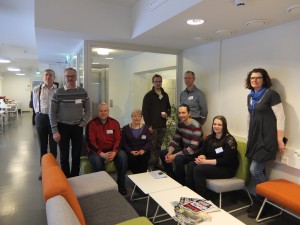On 29 January, the first meeting of the Adaptation Pilot (AP) Finland took place, for a Climate CAFE workshop where farmers were able to discuss and identify the key issues and potential strategies of Finnish agriculture under climate change.
Climate change forecasts have identified several transformations in Finnish climate, but the main risks for agriculture will be caused by:
- Decrease of snow cover and soil frost, presenting risks for overwintering crops and an increase in the incidence of pests and diseases.
- Increase in precipitation amount, with more intensity and erratic patterns. This might delay the ripening of crops and management operations, mainly sowing and harvesting.
- Increase in temperature extremes and lengthening of drought periods, along with the extension of the growing season. New cultivars are needed that can tolerate high temperatures or make use of the longer growing season, and there is a possibility to explore new crops due to the longer growing season.
The farmers identified what they felt were the key issues and questions for Finnish agriculture under climate change, and what could be the potential adaptation strategies for the forecast climate change scenario, and discussed which among those would be the most feasible.

Some issues, such as frost-heaving of overwintering crops, are likely to be unique to this AP. Others, such as water management, are likely to be more widespread.
The farmers saw water management as a key question: how to deal with the excess in winter without running into deficit in the summer. Many aspects of soil structure, particularly soil organic matter content, can be used as tools to manage water balance.
Moreover, the rental of fields is another important issue of Finnish agriculture. Farmers rent fields from other farmers, usually those who develop their farm and make investments rent from those who have given up practical farming but are not willing to sell their land. The users of the land, in this case, have little concern about its future, so they are unlikely to invest in it, in contrast to the land that they themselves own, while the land-owners are equally unlikely to invest in it since they will not see much financial benefit from it.
Overall, the maintenance and improvement of soil structure through maintaining crop cover, improving drainage systems and addition of organic matter are the main identified feasible strategies for farmers to adapt to climate change events (drought, floods, etc.). In addition, the short-term nature of field rental contracts is the main barrier for soil improving activities, because it makes no sense to make new sub-drainage or other soil improving activities if you can’t be sure that you will continue to cultivate the field after five years.